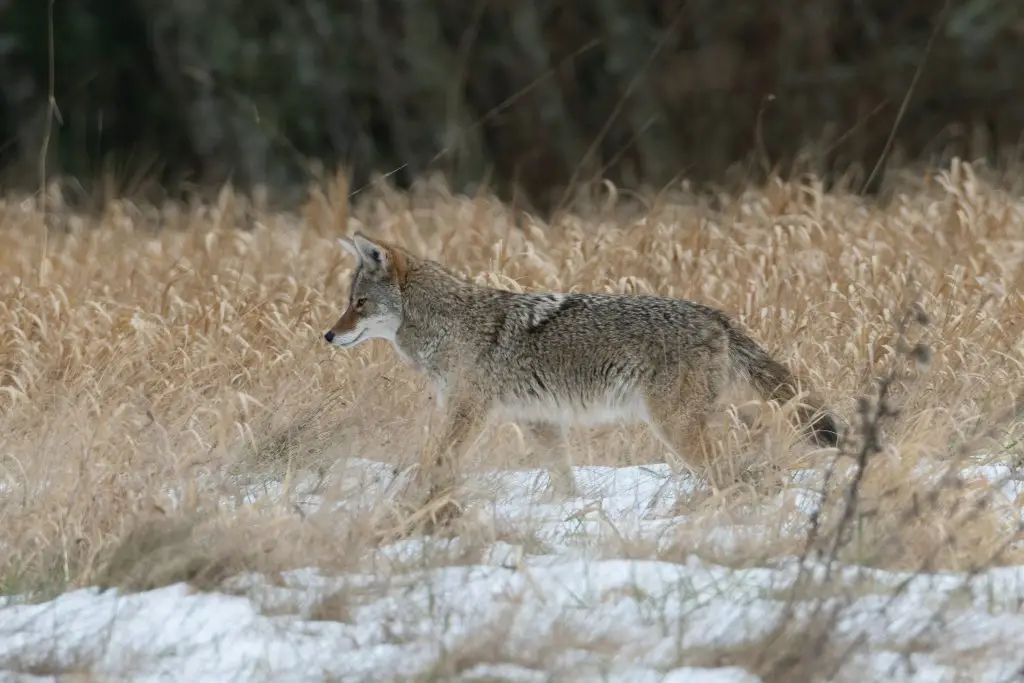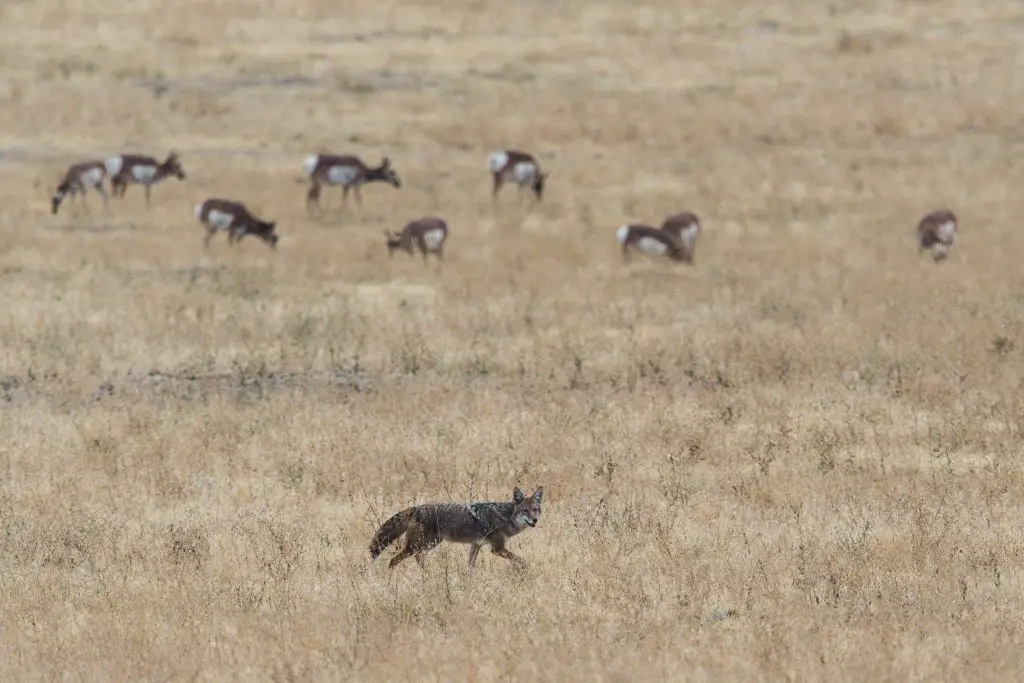It’s no secret that coyotes can be a nuisance. They often invade trash cans and gardens in search of food, and they have even been known to attack small pets or even the very rare case of attacking people. If you’re tired of dealing with these pesky critters, then you’ll need to know how to scare away a coyote. Fortunately, there are a number of things you can do to deter coyotes from your property.
Audible Deterrents for Coyotes
When it comes to scaring away coyotes, a very effective way is loud noise directed at the coyote. The louder the better. There are a few ways to make loud noise, such as using an air horn or whistle, banging pots and pans together, or yelling, clapping your hands, or stomping your feet. The key is to be as loud and sudden as possible so the coyote feels startled and leaves the area.
Visual Deterrents for Coyotes
We all know how pesky coyotes can be. They’re always around, raiding our trash cans and generally being a nuisance. Visual deterrents can be a good option, and can often not require any direct action from you to be effective.
Here are a few tips:
- Put Up Fences or Walls That the Coyote Cannot See Through. This will prevent them from being able to see what’s on the other side, and they’ll be less likely to approach.
- Use Reflectors or flashing bright lights. Motion-activated lights are very effective. These will startle the coyote and make them think twice about approaching your property.

Other Methods to Deter Coyotes
- Use Smells That Coyotes Don’t Like – This could be anything from vinegar to chili peppers. Commercially available coyote repellent can also be a good option.
- Keep Your Pet Food and Garbage Securely Stored – Any food they can smell will attract them, and if they can access it that will draw them back more in the future. If, instead food containers and garbage cans are sealed up and inaccessible, they’ll move on to easier food sources.
- Clean up refuse in the yard – Fallen fruit from trees, pet treats, food scraps put out for other wild animals like bird feeders or squirrel feeders. Often these will attract rodent populations. Both the food items and the rodents can attract coyotes.
- Use coyote rollers – These are ingenious devices that are attached to the top of fences or walls. When a coyote attempts to crawl over, the rollers roll and the coyote falls back off the wall. This is similar to how people keep squirrels off bird feeders, and it can be very effective.
- Do not leave pets unattended for long – Small dogs and cats can unfortunately be very susceptible to coyote attacks. Let them out when needed, but call them back in if your yard is accessible to coyotes, particularly at night. It’s also recommended to feed pets indoors.
- Use that throwing arm – if needed, throw something at them. Rocks, sticks, tennis balls, anything you can hurl in their direction to scare them off.
- Coyotes HATE getting wet – people have utilized motion-activated sprinklers, or even a handy garden hose or squirt gun, to chase a wild coyote off.
Where and When You are Most Likely to Encounter a Coyote
Coyotes are wily creatures, but there are a few things you can do to scare them away and keep them away for good. Understanding their behavior is key to exploiting it.
As wolves were eliminated from many areas of North America, the coyote population exploded. Wolves not only compete with coyotes for food, but wolves will also prey on coyotes if they get the chance. Because of this natural enmity between them, wolf urine can also be a very effective deterrent, although this obviously is not readily available to most people.
The increase in population was and is not limited to rural areas, anyone living in or on the outskirts of a city know that suburban and even urban coyotes are not uncommon.
Farmers and ranchers deal with coyotes on a regular basis and keep close watch over their farm animals. Larger livestock animals like adult cows or horses have little to fear from a coyote, but sheep, pigs, lambs, and certainly geese, ducks or chickens are all easy targets.
In residential areas, a coyote problem can mean trouble for domestic or feral cats, and certainly a domestic dog, particularly if it’s a small breed. If there is a presence of coyotes in your area, and particularly if you have heard reports of negative interactions with them, you’ll likely want to call the non-emergency number for your local police department to make sure they’re aware and get any advice they may have to offer or updates on how the coyote sightings are being handled.

Coyotes are most active at dawn and dusk, so that’s when you’re most likely to see them. During the year the most likely time to encounter them is during mating season (January to March) and when juveniles start leaving the family pack (September to November). Juveniles in particular may not have developed a fear of humans yet.
You may spot coyotes if you’re out for a drive or a walk. You’ll see them crossing the street or moving through neighborhoods, especially in residential suburban areas bordering on open space where coyotes find their natural prey. They may simply be taking a shortcut to their favorite hunting ground. They’ll typically just move on and show no signs of aggressive behavior.
This type of sighting generally requires no response—other than making sure that pets and children are secure and that there are no likely food attractants (as discussed earlier) present in the area. Your best bet is to keep a safe distance and you likely won’t have any issues.
If you do encounter a coyote, remember to never run away from them. This will only trigger their natural instinct to chase. Instead, stand your ground, make yourself look as big as possible, and make loud noises until the coyote leaves the area.
If You Notice Coyotes in Your Neighborhood
If you notice coyotes in your neighborhood, there are some additional things you can do to scare them away. One way to scare them away is by using aversion conditioning.
This is when you pair an unpleasant stimulus with undesirable behavior. For example, you can pair the sound of a loud noise with the act of chasing the coyote. This will teach the coyote that the loud noise is unpleasant and that it should avoid the area where the noise is coming from.
Another way to scare away a coyote is by reaching out to your local fish and wildlife department for assistance. They may be able to help you with coyote hazing techniques that will encourage the coyote to move away from the area. This information should be shared with neighbors, friends and homeowner’s associations since hazing is most effective when the entire neighborhood is working together.
Remember, it is important to take action if you notice an uptick in coyote activity in your neighborhood. By using some of these scare tactics, you can help minimize your interactions with these animals.
What to Do If a Coyote Is Approaching You and Your Dog
If you’re out walking your dog and a coyote approaches, here’s what you should do:
- First and foremost, remain calm. If you scream or run away, you may trigger the coyote’s predatory response and it could start to chase you.
- Stand tall, make yourself look big, and wave your arms. This will usually be enough to scare the coyote away.
- If the coyote doesn’t back off, start shouting while walking in the direction of the coyote. Use a noisemaker if you have one, such as a whistle or a bell.
- If the coyote still doesn’t back down, you can try throwing something at it, such as a rock or a stick.
- If all else fails and the coyote does attack, fight back! Use whatever you have to defend yourself, such as pepper spray or a bat.
Remember, never run away from a coyote. Stand your ground and you’ll usually be able to scare it off.


Leave a Reply